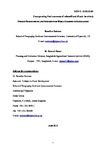Energy productivity and efficiency of wheat farming in Bangladesh
| dc.contributor.author | Rahman, Sanzidur | |
| dc.contributor.author | Hasan, MK | |
| dc.date.accessioned | 2015-12-24T16:50:28Z | |
| dc.date.available | 2015-12-24T16:50:28Z | |
| dc.date.issued | 2014-03-18 | |
| dc.identifier.issn | 0360-5442 | |
| dc.identifier.issn | 1873-6785 | |
| dc.identifier.uri | http://hdl.handle.net/10026.1/3997 | |
| dc.description.abstract |
Wheat is the second most important cereal crop in Bangladesh and production is highly sensitive to variations in the environment. We estimate productivity and energy efficiency of wheat farming in Bangladesh by applying a stochastic production frontier approach while accounting for the environmental constraints affecting production. Wheat farming is energy efficient with a net energy balance of 20,596MJ per ha and energy ratio of 2.34. Environmental constraints such as a combination of unsuitable land, weed and pest attack, bad weather, planting delay and infertile soils significantly reduce wheat production and its energy efficiency. Environmental constraints account for a mean energy efficiency of 3 percentage points. Mean technical efficiency is 88% thereby indicating that elimination of inefficiencies can increase wheat energy output by 12%. Farmers' education, access to agricultural information and training in wheat production significantly improves efficiency, whereas events such as a delay in planting and first fertilization significantly reduce it. Policy recommendations include development of varieties that are resistant to environmental constraints and suitable for marginal areas; improvement of wheat farming practices; and investments in education and training of farmers as well as dissemination of information. © 2014 Elsevier Ltd. | |
| dc.format.extent | 107-114 | |
| dc.language | English | |
| dc.language.iso | English | |
| dc.publisher | Elsevier | |
| dc.subject | Energy productivity | |
| dc.subject | Energy efficiency | |
| dc.subject | Environmental constraints | |
| dc.subject | Stochastic production frontier | |
| dc.subject | Wheat | |
| dc.subject | Bangladesh | |
| dc.title | Energy productivity and efficiency of wheat farming in Bangladesh | |
| dc.type | journal-article | |
| dc.type | Article | |
| plymouth.author-url | https://www.webofscience.com/api/gateway?GWVersion=2&SrcApp=PARTNER_APP&SrcAuth=LinksAMR&KeyUT=WOS:000334262000017&DestLinkType=FullRecord&DestApp=ALL_WOS&UsrCustomerID=11bb513d99f797142bcfeffcc58ea008 | |
| plymouth.volume | 66 | |
| plymouth.publication-status | Published | |
| plymouth.journal | Energy | |
| dc.identifier.doi | 10.1016/j.energy.2013.12.070 | |
| plymouth.organisational-group | /Plymouth | |
| plymouth.organisational-group | /Plymouth/Faculty of Arts, Humanities and Business | |
| plymouth.organisational-group | /Plymouth/Users by role | |
| dc.publisher.place | Netherlands | |
| dc.identifier.eissn | 1873-6785 | |
| dc.rights.embargoperiod | Not known | |
| rioxxterms.versionofrecord | 10.1016/j.energy.2013.12.070 | |
| rioxxterms.licenseref.uri | http://www.rioxx.net/licenses/all-rights-reserved | |
| rioxxterms.type | Journal Article/Review |


